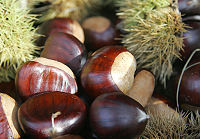
Photo from wikipedia
Abstract Objective: Nut consumption is associated with a range of health benefits. The current study aimed to examine nut consumption in the 2011–2012 National Nutrition and Physical Activity Survey (NNPAS)… Click to show full abstract
Abstract Objective: Nut consumption is associated with a range of health benefits. The current study aimed to examine nut consumption in the 2011–2012 National Nutrition and Physical Activity Survey (NNPAS) and to investigate associations between nut intake, nutrient intake and anthropometric and blood pressure measurements. Design: Secondary analysis of the 2011–2012 NNPAS. Usual consumption of nuts in the 2011–2012 NNPAS was determined, and nut consumption was compared with population recommendations of 30 g nuts per day. The relationship between nut consumption and intakes of key nutrients, anthropometric outcomes (weight, BMI and waist circumference) and blood pressure was examined using linear regression for participants aged over 18 years. Setting: Australia. Participants: Australians (2 years and older, n 12 153) participating in the representative 2011–2012 NNPAS. Results: Mean nut intake was 4·61 (95 % CI: 4·36, 4·86) g/d, with only 5·6 % of nut consumers consuming 30 g of nuts per day. Nut consumption was associated with significantly greater intakes of fibre, vitamin E, Fe, Mg and P. There was no association between nut consumption and body weight, BMI, waist circumference, or blood pressure. Conclusions: Exploration of nut consumption in a representative sample of Australians identified that nut intake does not meet recommendations. Higher nut consumption was not adversely associated with higher body weight, aligning with the current evidence base. Given the current levels of nut consumption in Australia, strategies to increase nut intake to recommended levels are required.
Journal Title: Public Health Nutrition
Year Published: 2020
Link to full text (if available)
Share on Social Media: Sign Up to like & get
recommendations!